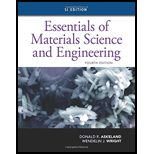
Interpretation:
The inter planar spacing, the length of the Burgers
Concept Introduction:
The formula used is:
Here,
Answer to Problem 4.29P
The length of Burgers vector for slip system
The inter planar spacing for lip system of plane
The length of Burgers vector for slip system
The inter planar spacing for slip system of plane
The ratio of shear stresses required for two slip systems is
Explanation of Solution
Plane:
The length of Burgers vector for slip system
Here,
The lattice parameter
Substituting as
Hence, the length of Burgers vector for slip system
The inter planar spacing for slip system of plane
Here, Miller indices of adjacent planes are
Substitute
The length of Burgers vector for slip system
Here,
The lattice parameter
Substitute
The inter planar spacing for slip system of plane
Here, Miller indices of adjacent planes are
Substitute
Hence, the inter planar spacing for slip system of plane
The ratio between the inter planar spacing and length of Burgers vector for slip system of
Substitute
The ratio between the inter planar spacing and length of Burgers vector for slip system of
Substitute
The ratio of shear stresses required for two slip system is calculated as:
Substitute
Hence, the ratio of shear stresses required for two slip systems is
The length of Burgers vector for slip system
The inter planar spacing for lip system of plane
The length of Burgers vector for slip system
The inter planar spacing for slip system of plane
The ratio of shear stresses required for two slip systems is
Want to see more full solutions like this?
Chapter 4 Solutions
Essentials Of Materials Science And Engineering, Si Edition
- Need help with this in python!arrow_forward. The average soil weights for a clay are the following: 2,050 pounds in Loose CY, 2,675pounds in Bank CY, and 2,835 pounds in Compacted CY What is the swell percentage for theclay?arrow_forwardA traffic count taken between 7:00 a.m. and 2:00 p.m. on a rural highway found the following hourly volumes. Time 7:00-8:00 a.m. Hourly volume 332 8:00-9:00 a.m. 311 9:00-10:00 a.m. 263 10:00-11:00 a.m. 273 11:00 a.m.-12:00 p.m. 289 12:00-1:00 p.m. 1:00-2:00 p.m. 286 265 If these data were collected on a Tuesday in February, estimate the AADT (in veh/day) on this section of highway. Assume that the expansion factors given in this table, this table, and this table apply. veh/dayarrow_forward
- A project schedule has been updated. The activity placement of spread footing concretewas originally scheduled to begin as early as day 10. The activity duration is 4 days. The actualstart day was day 12. The original schedule had a calculated total float of 7 days for this activity.The recalculated total float for the activity, when updated, would bearrow_forwardNeed help with this in python!arrow_forwardIn preparation for a public hearing, an engineer needs to estimate the travel time savings for a proposed highway bypass of a small city in a rural area. The existing highway goes through the downtown area for 4.1 miles between the points where the bypass will connect. (a) If the engineer anticipates a standard deviation of 7 mi/h and would like a 95% confidence of estimating the mean speed within ±4 mi/h, how many runs should a travel time study include? (Enter the minimum number of runs that achieves a 95% confidence level.) runs (b) If the engineer measures an average speed of 34.9 mi/h through the town and the bypass is expected to operate at speeds of 65 mi/h over a distance of 6.2 miles, what is the expected travel time saving (in minutes) per vehicle? minutes Need Help? Read It Watch Itarrow_forward
- Help! How do I turn the flowchart that searches for a name in an array of names into structured and spaced pseudocode?arrow_forwardDatabasearrow_forwardA Si step junction maintained at room temperature under equilibrium conditions has a p-side doping of NA 2X1015/cm³ and an n-side doping of ND=1015/cm³. Compare a) Vbi b) Xp, Xn, and W c) ɛ at x=0 d) V at x=0 Make sketches that are roughly to scale of the charge density, electric field, and electrostatic potential as a function of position.arrow_forward
- follow the instructions and make sure to right the complete solutionarrow_forwardThe mail merge process has ____ steps. Question 19Select one: a. five b. six c. seven d. eightarrow_forwardIf you created a main document based on an existing document entitled "Confirmation Letter," what default filename would Word give the main document? Question 14Select one: a. Confirmation Letter-1 b. Confirmation Letter-merge c. Document1 d. MergedDocument1arrow_forward
 MATLAB: An Introduction with ApplicationsEngineeringISBN:9781119256830Author:Amos GilatPublisher:John Wiley & Sons Inc
MATLAB: An Introduction with ApplicationsEngineeringISBN:9781119256830Author:Amos GilatPublisher:John Wiley & Sons Inc Essentials Of Materials Science And EngineeringEngineeringISBN:9781337385497Author:WRIGHT, Wendelin J.Publisher:Cengage,
Essentials Of Materials Science And EngineeringEngineeringISBN:9781337385497Author:WRIGHT, Wendelin J.Publisher:Cengage, Industrial Motor ControlEngineeringISBN:9781133691808Author:Stephen HermanPublisher:Cengage Learning
Industrial Motor ControlEngineeringISBN:9781133691808Author:Stephen HermanPublisher:Cengage Learning Basics Of Engineering EconomyEngineeringISBN:9780073376356Author:Leland Blank, Anthony TarquinPublisher:MCGRAW-HILL HIGHER EDUCATION
Basics Of Engineering EconomyEngineeringISBN:9780073376356Author:Leland Blank, Anthony TarquinPublisher:MCGRAW-HILL HIGHER EDUCATION Structural Steel Design (6th Edition)EngineeringISBN:9780134589657Author:Jack C. McCormac, Stephen F. CsernakPublisher:PEARSON
Structural Steel Design (6th Edition)EngineeringISBN:9780134589657Author:Jack C. McCormac, Stephen F. CsernakPublisher:PEARSON Fundamentals of Materials Science and Engineering...EngineeringISBN:9781119175483Author:William D. Callister Jr., David G. RethwischPublisher:WILEY
Fundamentals of Materials Science and Engineering...EngineeringISBN:9781119175483Author:William D. Callister Jr., David G. RethwischPublisher:WILEY





